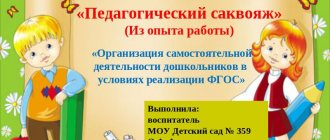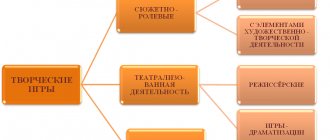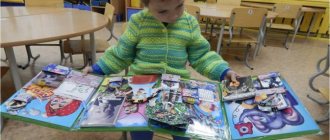What is “connected speech”?
An utterance or coherent speech is several complete segments (sentences) that are connected thematically, in meaning, and in structure. It serves to facilitate communication and is expressed in two forms:
- monologue - the ability to talk about a certain image, action, etc.;
- Dialogue is direct interaction with another person or people through communication.
Statements are the result of perception, comprehension, and the ability to express one’s thoughts. Coherent speech gives a clear understanding of the relationship between a child’s mental and speech development and helps solve problems in all areas of upbringing and education.
Monologue speech of older preschoolers consists of several main types:
- description - includes the general name of the object (action), a listing of its properties, qualities, and in conclusion - an assessment or attitude towards it (parts of this structure can be rearranged);
- narration is a statement of fact in which the beginning of the story, its culmination, outcome or denouement is clearly visible;
- reasoning is a separate type of statement that reflects a certain connection of events, facts, phenomena (consists of a statement, evidence, conclusion).
All these variants of coherent speech are found in children in a mixed form.
The initial and most important stage in the development of coherent speech in children is dialogue. It reveals the specifics of interaction, allows you to convey to the child the norms and rules for the further construction of monologue speech according to the laws of the literary language.
In order to correctly organize work on the formation of coherent speech in preschoolers, it is necessary to know the stages of its development, as well as to identify the main tasks for each type of speech separately.
Mini-lessons
Mini-classes of speech development are recommended by current programs to be used as special forms of speech development in work with children of the third year of life as often as possible (preferably daily), because they are relevant and correspond to the personality-oriented model of preschool education. This form of organizing speech activity can be initiated by the teacher, then they are provided for in the work calendar, or it can arise on the initiative of the children. The teacher must be prepared to guide such speech activity of the child.
The part of the word “mini”, according to A. Goncharenko, implies minimization:
- by the number of children who are simultaneously employed;
- by duration of organized activity;
- by the volume of content that is sold.
The number of mini-lessons and their content are determined by age characteristics. During the day, the teacher can organize himself or create conditions for children to self-organize dozens of individual, group and collective short-term mini-lessons, during which the planned topic will be implemented.
Reasons for the delay in the formation of coherent speech in children
To determine the level of development of coherent speech, you need to analyze compliance with the age criteria listed above, that is, make a kind of diagnosis. It should be carried out in a playful way, without focusing the child’s attention on the result, without making comments, without correcting, without teaching. Just create a situation and observe the behavior and speech of a preschooler.
Difficulties and difficulties in speech development can occur in children for medical reasons:
- pathology of intrauterine development (mother's exposure to infectious diseases, intense toxicosis);
- birth injuries (asphyxia, premature birth, infection, etc.);
- childhood head trauma, especially in the area of speech zones;
- hearing or speech impairment (the latter is diagnosed by age 5).
There are also social reasons that slow down the development of coherent speech in a child:
- pedagogical neglect - they do not work with the child or the child exhibits behavioral disorders (“difficult child”);
- lack of communication in a family - the lack of direct, close communication between all its members, when several people simply exist under one roof;
- change of place of residence, especially in a foreign-language environment - if at home they speak one language, in a child care center and on the street - in another, the child experiences difficulties in mastering speech skills.
Excessive care can also lead to speech delays, since the child simply does not need to speak if his wishes are guessed and instantly fulfilled.
As a rule, by the age of 5-6 years a child can:
- consistently answer questions;
- compose short narratives based on illustrations;
- describe your impressions of what you saw;
- convey the content of what was heard or seen from memory;
- come up with a continuation of a fairy tale, fantasize.
But in order for the result to meet age requirements, it is necessary to pay enough attention to communication and activities with the child at each stage of growing up.
Integrated classes
Integrated forms of classes for consolidating acquired knowledge, skills and speech habits with children of the third year of life can be carried out 1-2 times a quarter. In these classes, the teacher uses material from different sections of the program, combining several areas of children's activities (for example, speech and visual arts, speech and cognitive). The priority in such classes is the communicative activity of children, the unifying point is the theme.
In early age groups of 2-3 years old, it is advisable to conduct educational and game integrated classes, which provide for the presence of a game plot and a single storyline.
Mini-lesson structure
A. Krikun recommends including the following in the structure of mini-lessons:
- joint musical congratulations, which are aimed at developing a communicative culture, with elements of psycho-gymnastics;
- elements of visual activity, which are accompanied by verbal commentary.
All components of such activities can be united by a single plot, the basis of which is a certain lexical topic, for example, “Transport”, “Our toys”, “How the little bunny looked for its mother”, etc., the application of which can be various tasks and activities. Each topic requires the selection of certain material. It is advisable to combine outdoor, board, finger games, dances, songs, poetic material, health exercises, fairy tales; You can use elements of various developmental techniques.
Mini-lessons with kids end with a joint summing up and relaxation exercises.
Complex classes
A complex lesson in its structure combines at least three speech tasks. Tasks for the development of communicative activity (dialogical and coherent speech) are implemented at each of them; tasks of vocabulary work, sound culture of speech and grammatical structure of the language as part of a complex lesson are planned twice a month. The teacher himself determines which part of the lesson to start from, depending on the complexity of the tasks and the age of the children.
Approximate structure of a complex lesson: I week - communicative activity + sound culture of speech + grammar; Week II - communicative activity + grammar + vocabulary; Week III - communicative activity + vocabulary + sound culture of speech.




